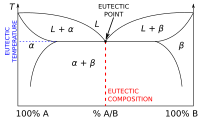
Photo from wikipedia
This chapter introduces the basic concepts of the phases and constituents present in the simpler steels in conditions near equilibrium. The discussion focuses on the iron-carbon (Fe–C) system. Understanding these… Click to show full abstract
This chapter introduces the basic concepts of the phases and constituents present in the simpler steels in conditions near equilibrium. The discussion focuses on the iron-carbon (Fe–C) system. Understanding these concepts is fundamental for a proper understanding of the transformations that occur during steel solidification, heat treatments, and thermomechanical processing. Discussion of the Fe–C system is of paramount importance to understanding many phenomena that also occur in complex alloy steels. The combination of chemical composition and structure defines the properties and hence the performance of steels. Chemical composition is controlled essentially during the steelmaking processes, although the composition close to the part surface can be affected by thermochemical treatments in the solid state. Structure, on the other hand, is altered by the combination of deformation and temperature change, normally grouped under the name of thermomechanical treatments. Producing phase transformations between the two main crystal structures of iron, body-centered cubic (BCC) and face-centered cubic (FCC) and forming structures other than equilibrium structures with interesting properties in terms of application and with reasonable stability are possibly the two main reasons that explain the wide use of steels as industrial materials. A main objective of this book is to present the structures that result from applying different thermomechanical treatments of steels with various chemical compositions, in particular the size scale evaluated through metallography. Underlying the effect of these treatments on steels with different chemical compositions is the concept of phase transformation. The way steel undergoes phase transformations in the different stages of its processing is a critical factor in defining the features and properties of the structures formed. While the object of this book is not the in-depth study of phase transformations, the reader should be familiar with the concepts that control these transformations. Here, only the fundamental aspects essential to understanding the features presented are discussed; excellent literature is available on the subject at different levels of complexity in [1–4].
Journal Title: Metallography, Microstructure, and Analysis
Year Published: 2017
Link to full text (if available)
Share on Social Media: Sign Up to like & get
recommendations!